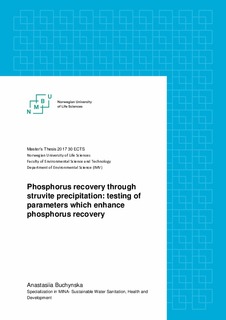| dc.description.abstract | Phosphorus is an essential nutrient for growth in all living organisms and is used as fertilizer to maintain food production. Today's recovery of mineral phosphate will lead to a lack of phos-phorus as mineral fertilizer since phosphorus will become more expensive over the time. In-creased awareness that the mineral phosphate is not a renewable resource means that recycling of phosphorus is an important environmental and food safety issue.
In the given thesis, the recovery of phosphorus was carried out by the precipitation of the am-monium-magnesium-phosphate (struvite) complex. The overriding purpose was to determine the optimal parameters for phosphates removal through the struvite precipitation from the re-ject- and sludge- wastewater after the biological treatment from the HIAS sewage plant in Hamar, Norway. Furthermore, the goal was to achieve a struvite with the high nutrients content and use it as a potential fertilizer. To accomplish that goal it was formed hypotheses, made the experiments, analysis, and results.
Based on the theory, three hypotheses were formed, which are focused on varying the parame-ters time, pH and molar ratio of Mg2+: NH4+. Firstly, an increase in pH from 8 to 8.3 should increase phosphorus removal through struvite precipitation. Secondly, the reaction time plays role in phosphorus recovery. Thus, the reaction time in the interval 20 to 60 min should be optimal for struvite formation with the high P-recovery. Thirdly, the molar ratio of Mg2+: NH4+ at 1.2: 10 and 1.5: 10: should cause about 95% of P removal. Finally, the concentration of toxic elements, such as heavy metals, was expected to meet the legislations requirements after the experiments.
To carry out the experiments, two sources of wastewater have been taken from the HIAS, mixed and added the salt of magnesium. The solution has been mixed and centrifuged. Both the liquid part and the sediment (struvite) have been analyzed. The struvite was weighted and analyzed
iv
on the content of elements. The liquid part was analyzed on phosphorus and ammonium recov-ery, turbidity, conductivity and the content of elements.
The results showed the highest phosphorus recovery of 97% was achieved by the Mg2+: NH4+ molar ratio of 1.5:10 and the pH 8.3, which looks like the optimum combination for PO43- re-covery. All the experiments showed the same ammonium recovery, at about 68.5%. 20 min reaction time showed better struvite removal than at 60 min. It was found that, although, the amount of struvite sedimentation was small, the quality of precipitated struvite was high. The struvite contains a very low number of toxic elements, which are less than in the legislations requirements.
The results showed that the Mg2+: NH4+ molar ratio and the pH plays key role in enhancing of phosphorus recovery through struvite precipitation. Moreover, the changing in time also can affect the quality of struvite as a future fertilizer. | nb_NO |

